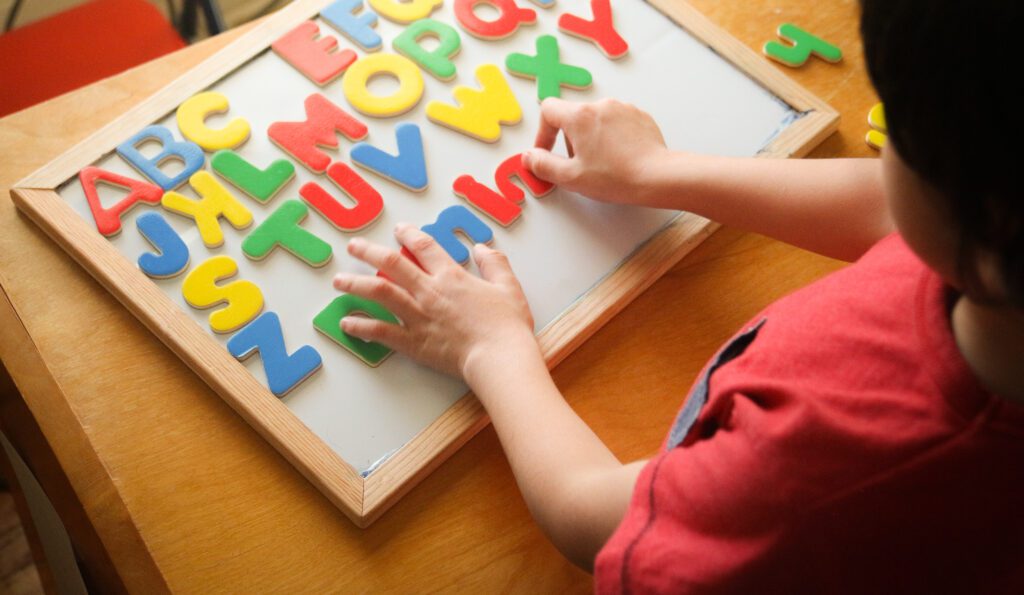 Book a Tour
Book a Tour WhatsApp
WhatsApp Join Waitlist
Join Waitlist
Embarking on the journey of learning the alphabet is an exciting milestone for young children. As parents and caregivers, we have the opportunity to make this learning process engaging, interactive, and fun. By infusing creativity into alphabet lessons, we can capture children’s imaginations and foster a love for language and literacy that will last a lifetime. In this blog, we’ll explore some creative ways to teach letters to children, turning each lesson into an adventure of learning.

1. Alphabet Scavenger Hunt:
Transform your home into a treasure trove of letters with an alphabet scavenger hunt! Create a list of letters for your child to find around the house, whether on cereal boxes in the kitchen, books on the shelf, or toys in the playroom. As they search, they’ll not only practice letter recognition but also develop their observation skills in a playful and engaging way.
2. Sensory Letter Play:
Bring letters to life with sensory play activities that engage multiple senses. Fill a tray with salt, sand, or shaving cream and invite your child to trace letters with their fingers, feeling the texture and shape of each letter as they go. You can also use materials like playdough or clay to mould letters, adding a tactile element that enhances memory and retention.
3. Alphabet Art:
Get creative with letter-themed art projects that inspire imagination and self-expression. From finger painting letter masterpieces to collage creations using magazine cutouts, the possibilities are endless. Encourage your child to incorporate letters into their artwork, whether it’s by shaping letters with pipe cleaners or using alphabet stamps to add letters to their masterpiece.
4. Letter Recognition Games:
Turn letter recognition into a game with interactive activities that make learning feel like play. Create a letter-matching game using flashcards or magnetic letters, challenging your child to match uppercase and lowercase letters or find letters that correspond to objects around the house. You can also play “I Spy” with letters, or try out a ‘’memory’’ game to practice matching letters.
5. Storybook Reading:
Immerse your child in the world of letters with alphabet-themed storybooks that make learning fun and engaging. Choose books that feature each letter of the alphabet prominently, whether it’s through characters, settings, or objects. As you read together, encourage your child to identify letters they recognise and point out new letters they encounter, fostering a love for reading and literacy from an early age.
6. Reading Eggs:
This multi-award-winning app created by the ABC has already helped more than 10 million children learn to read. With hundreds of online reading lessons, phonics games and books for ages 2–13, your child can explore the alphabet in numerous creative ways. With Reading Eggs, the adventure of learning the alphabet continues beyond the classroom, providing endless opportunities for exploration and growth.
7. Songs and Rhymes:
Introducing songs and rhymes into your child’s daily routine can transform letter learning into a joyful and memorable experience. Whether it’s singing the classic “ABC Song” or reciting nursery rhymes that feature letters prominently, music adds a delightful element to the alphabet journey. Through rhythmic repetition, children internalise letter sequences and phonetic patterns, enhancing their ability to recognise and recall letters effortlessly. Additionally, songs and rhymes stimulate language development, rhythm perception, and auditory processing skills, laying a strong foundation for literacy.
Teaching the alphabet is more than just a lesson; it’s an adventure in learning and discovery. By infusing creativity into alphabet lessons, we spark children’s curiosity, imagination, and enthusiasm for language and literacy. From alphabet scavenger hunts to sensory letter play, art adventures, and interactive games, the possibilities for engaging learning opportunities are endless. At Heritage House Childcare & Early Learning Centres, we integrate these creative methods into our Transition to School program and day-to-day activites, fostering a love for language and literacy in our children.